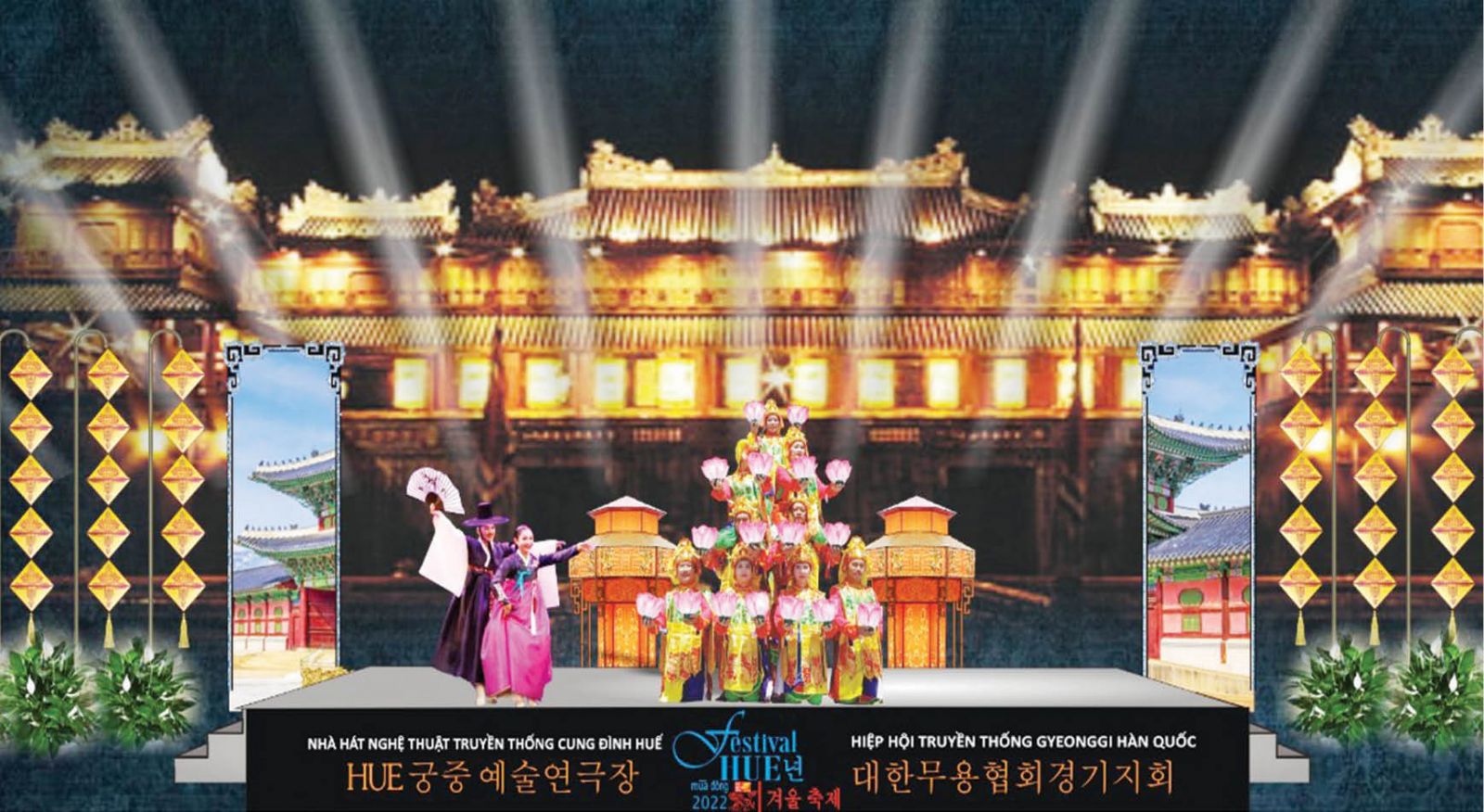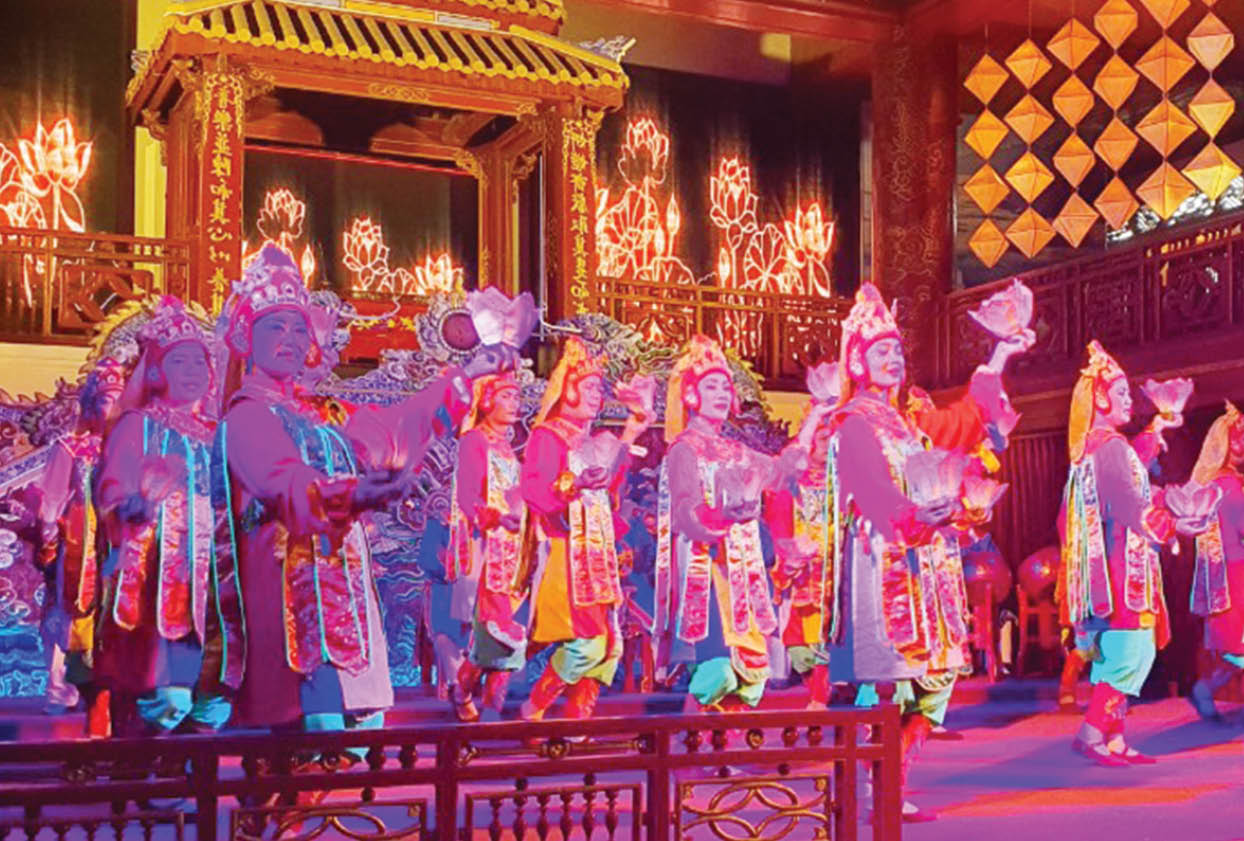This is a performance program by Hue Royal Traditional Arts Theater in collaboration with the Korean Gyeonggi Dance Association at the stage in front of Ngo Mon at 8 pm on November 25, 2022. It is also an activity on the occasion of Vietnam Cultural Heritage Day.

Poster for "Dance of harmony"
The program has 12 main performances, opening with the concert "Vong Kinh Ky" performed by the traditional orchestra, giving an overview of the construction of the ancient capital.
Next is the harmony between the traditional dances of Vietnam and Korea. Royal dances such as Phung Vu, Trinh Tuong Tap Khanh, Luc Triet Hoa Ma Dang, and Luc Cung Hoa Dang accompanied by elegant music will create a joyful and elegant timbre bearing the philosophy of the royal dances.
The art of Hue royal dance is imbued with oriental philosophy and aesthetics. In royal dance, the smooth combination of dance movements, the movement of horizontal, vertical, and diagonal formations plus the creation of block shapes make up its own characteristics.
Typically, the Luc Cung Hoa Dang dance which originated from Buddhist rituals was brought into the royal court and staged to become a dance performance on the birthdays of the Empress Dowager, Emperor and Crown Prince.
In the dance, both male and female dancers, dressed as Kim Dong (fairy boy), Ngoc Nu (fairy girl) holding two lotus flower lantern pots in both hands, dance and sing in the shimmering, dim light of the lotus flowers, creating a solemn and beautiful atmosphere.
The Trinh Tuong Tap Khanh dance was used in celebrations of the emperor’s 40th and 50th birthdays. This dance features four dancers who transform into four fairies in costumes with colors symbolizing the four directions. The majestic fairies obey heaven's orders, gathering from the air and then landing on earth, each person holding a verse of wishes. They would praise the emperor with the wishes such as Long live the Son of Heaven, Eternal life, Blessings from all directions, Offering all good omens...

Performance of "Luc Cung Hoa Dang" in Duyet Thi Duong Theater
Over time, those humanistic values have been preserved, transmitted and promoted to become a traditional art form of the royal court. The dances have come from the royal palace and then merged into contemporary life with a new aesthetic breath. Royal dances and court music are the representative intangible cultural heritage of humanity that has been practiced for 20 years, promoting their values in the ancient capital and performance spaces inside and outside the country.
In harmony with Hue royal dance, the Korean Gyeonggi Dance Association participated in dance performances that are intangible heritages of the "land of the Kimchi" such as Jindo Drum Dance, Tae Pyung Mu Crane Dance which are intangible cultural heritages Gyeonggi-do No. 27, No. 34 of Korea.
The charming Hanryangmu dance is associated with the traditional dance ground of the Gyeongbokgung Folk Museum. The ancient Sogo dance is handed down from the dance performed by Sogochibae of Nongak, Gyobang that dates back hundreds of years.
In particular, the liberal dance (Sunsori Santaryeong) is a special national intangible cultural heritage of Korea No. 92. This is a dance consisting of many different rhythms, along with gentle, moderate steps and skips to highlight charisma and skills. The traditional Gyobangmu dance was formed by a female dance group in the Goryeo Dynasty (918-1392). Dancers called Gyobang have a talent for singing and dancing and performing in many places.
"Dance of harmony" is an activity on the occasion of the 30th anniversary (December 22, 1992 - December 22, 2022) of the establishment of Vietnam - Korea relations. This is a program connected within the framework of cooperation between Hue Monuments Conservation Center and the Association of Performing Arts in Korea.
Story and photos: Hai Trung
